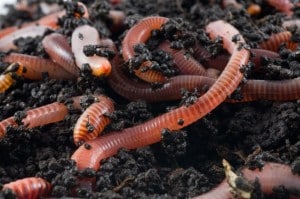
 Ask someone on our team whether worms have superpowers, and we’ll quickly confirm that, yes, they absolutely do. Just take one look at a worm and you’ll see what we mean. These incredible creatures slip into ringed brown-and-pink body suits, work their muscles from head to foot and wriggle their way through the soil to leave nutrient-rich castings behind. What other person or animal can give that kind of high-energy, high-impact performance?
Ask someone on our team whether worms have superpowers, and we’ll quickly confirm that, yes, they absolutely do. Just take one look at a worm and you’ll see what we mean. These incredible creatures slip into ringed brown-and-pink body suits, work their muscles from head to foot and wriggle their way through the soil to leave nutrient-rich castings behind. What other person or animal can give that kind of high-energy, high-impact performance?
To make those superpowers work at scale, they need a little help from human counterparts. At Worm Power, we operate across more than 80,000 square feet of covered and indoor space to give worms room to do their best work. That makes our office one of the largest controlled-environment vermicomposting facilities anywhere in the world. Think of it as the Superdome of superhero worms, like a gym and an arena rolled into one.
There are four key steps to creating Worm Power Liquid Extract that helps so many growers get the most from their plants. Here’s a peek behind the curtain at how these worms make that magic possible.
Step #1: Feedstock Sourcing
We source manure from New York dairy Coyne Farm, which takes great care of its cows and the feed they eat. The best manure goes through a separator, which divides liquids from solids. Then, we mix the solid manure with something called silage—plant matter grown on the dairy from crops such as corn, hay and alfalfa. There’s a special formula we use to ensure the carbon-to-nitrogen ratio is just right. This helps produce worm castings that are uniform and consistent, ensuring an excellent final product at the end of the four-step process.
Step #2: Thermophilic Composting
To gear up for the vermicomposting process, we rest our compost material—which has been shaped into bales—in a special building. The bales are aerated, which allows us to blow air into them and accelerate the aerobic digestion process. If that sounds like a lot of hot air, you’re right. Temperatures naturally stay above 130 degrees Fahrenheit to ensure composting is completed and to kill off pathogens. Then, the process is repeated in another compost bay for another 30 days. That extra step gives us another chance to make sure the compost is primed, ready and safe for worms.
Step #3: Vermicomposting
If you thought the earlier steps were fun, we’re just getting started! Once those compost bales arrive at the vermicompost building, they are placed inside of feeding bins, which apply the food onto worm digester beds. This isn’t your average king or queen; these beds are 200 feet long, hold up to 24 inches of material and contain roughly 8 million worms. Talk about a slumber party to remember! And there’s no sleeping going on. These red wriggler worms chow down on the compost and leave behind castings. We ensure moisture and temperature are at proper levels to keep the worms happy. Weekly, we add about 1.5 inches of new feed, and then we scrape off a similar amount of solid worm castings. At least 12 weeks later, the full process is complete and vermicomposting can be harvested at the bottom of the worm digester beds.
Step #4: Screening & Extract Production
It’s hard to spread or apply chunky vermicompost, which is why the final step of our process begins with screening. Materials are strained through quarter-inch screens, while water passes through carbon filters to take out any contamination or particulates. Solid vermicompost goes into filter bags and then into extract tanks. Then, the process of capturing consistent levels of water-soluble nutrients and microbiology into the liquid begins. Once the extract meets quality control standards, it’s filtered through three 200-mesh screens for packaging and distribution.
So there you have it: Worms get a little lift from their human companions and the result is a product that becomes a powerful soil amendment for organic and conventional growers, and for business owners as well as home gardeners. If you’re curious to learn more about how Worm Power can work for you, visit the Worm Power website or call us at 855-260-9676. We look forward to introducing you to nature’s wiggly superheroes—no capes required.